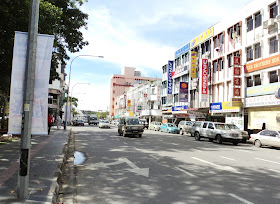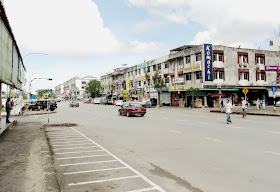In 1984 there was one major squatters demolition and resettlement project undertaken by the BDA with the help of the various government departments in Bintulu town area. In 1984 the the whole squatters area was cleaned up. The above picture depicts the seriousness of the squatters problems in Bintulu as even within the center of the Bintulu town the squatters had built their colony. It was evident that the rapid migration of temporary construction workers among the local Sarawakians looking for jobs in Bintulu were not met with sufficient affordable housing for many jobless Sarawakians. Thus they had no choice but to build up camp amidst the burgeoning squatters colony. Somewhere towards the upper right of the picture is seen the pitched roof of the old fish market ( behind the big umbrella). The Main Bazaar road during those time was a two-way street. The use of mechanised sweeper was a novelty among the local authorities in Sarawak. Bintulu was one of those local authorities that pride in having them to clean the streets daily.

Date taken : 29 Dec'10 ( Digital - Sony Cyber-shot)










